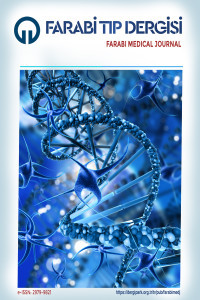Serum ve Plazma Örneklerinde İrisin Seviyesini Ölçmeden Önce Aprotinin İlave Etmek Gerekir mi?
İrisin, miktarı peroksizom proliferatörü ile aktive edilen reseptör gama koaktivatör1-α (PGC1-α) tarafından düzenlenen, 112 aminoasitten oluşan bir miyokindir. Bir tip I integral membran proteini olan fibronektin tip III domeini içeren protein 5’in (FNDC5) proteolitik parçalanması sonucu iskelet kası dokusundan kan dolaşımına salınır. Aprotinin çok değerlikli bir serin proteaz inhibitörüdür. Serum, plazma veya hücre homojenizatı gibi sulu çözelti örneklerine eklenerek, ortamda bulunan serin proteaz enzimlerini inhibe eder. Bu şekilde, ölçümü yapılacak olan proteinlerin parçalanması önlenir. Çok defa -80°C’de uzun süre saklanma ihtiyacı duyulan örneklerde irisin kaybının olup olmayacağı hakkında bir ön bilgi elde etmek amacı ile bu çalışma yapılmıştır. Bu amaçla, 25-40 yaş arasında 10 erkek ve 10 kadın gönüllüden kan örnekleri alınmış ve bunlardan elde edilen plazma ve serum örneklerine aprotinin eklenerek 3 ay -80°C’de saklanmıştır. 3 ay sonra, ELISA ile aprotininli ve aprotininsiz örneklerde irisin seviyeleri ölçülmüştür. Sonuçların istatistiksel değerlendirilmesiyle, aprotininli ve aprotininsiz plazma örneklerindeki irisin miktarlarında önemli bir farklılık olmadığı gözlemlenirken (p=0.525), aprotininli ve aprotininsiz serum örneklerindeki irisin miktarlarında anlamlı bir azalma bulunmuştur (p=0.009). Sonuç olarak, ELISA ile irisin tayin edilmek üzere 3 ay civarında -80°C’de saklanan plazma ve serum numunelerine aprotinin eklenmesinin gerekip gerekmediği konusunda net bir kanaate varılamamıştır.
Anahtar Kelimeler:
Aprotinin, İrisin, Serin Proteaz
Is It Necessary to Add Aprotinin Before Measuring The Level of Irisin in Serum and Plasma Samples?
Irisin is a myokine with 112 amino acids and its blood concentration is regulated by peroxisome proliferator-activated receptor-γ coactivator1-α (PGC1-α). It is released into circulation from skeletal muscle tissue after a photolytic cleavage of extracellular domain of Fibronectin type III domain-containing protein 5 (FNDC5), a type I integral membrane protein. Aprotinin is a polyvalent serin protease inhibitor. It is added to sample solutions such as serum, plasma or tissue extracts in order to inhibit serine proteases found in the sample medium. Hence, degradation of the proteins to be measured can be prevented. This study has been carried out to obtain a preliminary data if any irisin loss could be seen in the serum samples which are kept at -80°C for a long duration. For this purpose, blood samples of 10 men and 10 women volunteers aged between 25-40 has been used. Aprotinin has been added to the plasma and the serum samples have been kept at -80°C for 3 months. At the end of 3 months, irisin levels of the samples with and without aprotinin have been determined by ELISA. Statistical analysis has shown no difference between the plasma samples with or without aprotinin (p=0.525). However, a significant decrease between the serum samples with and without aprotinin (p=0.009). In conclusion, with the results of this study, no net decision could have been achieved to add aprotinin to the samples for irisin determination with ELISA in plasma and serum kept at -80°C for about 3 months.
Keywords:
Aprotinin, Irisin, Serine Protease,
___
- Boström P, Wu J, Jedrychowski MP, et al. A PGC1-α-dependent myokine that drives brown-fat-like development of white fat and thermogenesis. Nature. 2012; 481(7382): 463-468. DOI: 10.1038/nature10777.
- Handschin C, Spiegelman BM. The role of exercise and PGC1alpha in inflammation and chronic disease. Nature. 2008; 454(7203): 463-469. DOI: 10.1038/nature07206.
- Berchtold MW, Brinkmeier H, Müntener M. Calcium ion in skeletal muscle: its crucial role for muscle function, plasticity, and disease. Physiol Rev. 2000; 80(3): 1215-1265. DOI: 10.1152/physrev.2000.80.3.1215.
- Pilegaard H, Saltin B, Neufer PD. Exercise induces transient transcriptional activation of the PGC-1alpha gene in human skeletal muscle. J Physiol. 2003; 546(Pt 3): 851-858. DOI: 10.1113/jphysiol.2002.034850.
- Russell AP, Feilchenfeldt J, Schreiber S, et al. Endurance training in humans leads to fiber type-specific increases in levels of peroxisome proliferator-activated receptor-gamma coactivator-1 and peroxisome proliferator-activated receptor-alpha in skeletal muscle. Diabetes. 2003; 52(12): 2874-2881. DOI: 10.2337/diabetes.52.12.2874.
- Lidell ME, Enerbäck S. Brown adipose tissue--a new role in humans?. Nat Rev Endocrinol. 2010; 6(6): 319-325. DOI: 10.1038/nrendo.2010.64.
- Marlatt KL, Ravussin E. Brown Adipose Tissue: an Update on Recent Findings. Curr Obes Rep. 2017; 6(4): 389-396. DOI: 10.1007/s13679-017-0283-6.
- Mótyán JA, Tóth F, Tőzsér J. Research applications of proteolytic enzymes in molecular biology. Biomolecules. 2013; 3(4): 923-942. DOI: 10.3390/biom3040923.
- Antalis TM, Buzza MS, Hodge KM, Hooper JD, Netzel-Arnett S. The cutting edge: membrane-anchored serine protease activities in the pericellular microenvironment. Biochem J. 2010; 428(3): 325-346. DOI: 10.1042/BJ20100046.
- Craik CS, Page MJ, Madison EL. Proteases as therapeutics. Biochem J. 2011; 435(1): 1-16. DOI: 10.1042/BJ20100965.
- Antalis TM, Bugge TH, Wu Q. Membrane-anchored serine proteases in health and disease. Prog Mol Biol Transl Sci. 2011; 99: 1-50. DOI: 10.1016/B978-0-12-385504-6.00001-4.
- Seto S, Kher V, Scicli AG, Beierwaltes WH, Carretero OA. The effect of aprotinin (a serine protease inhibitor) on renal function and renin release. Hypertension. 1983; 5(6): 893-899. DOI: 10.1161/01.hyp.5.6.893.
- Soaresa T, Borba Ferreiraa FR, Gomes FS, et al. The first serine protease inhibitor from Lasiodora sp. (Araneae: Theraphosidae) hemocytes. Process Biochemistry. 2011; 46: 2317–2321. DOI: 10.1016/j.procbio.2011.09.012.
- Crujeiras AB, Pardo M, Arturo RR, et al. Longitudinal variation of circulating irisin after an energy restriction-induced weight loss and following weight regain in obese men and women. Am J Hum Biol. 2014; 26(2): 198-207. DOI: 10.1002/ajhb.22493.
- Choi ES, Kim MK, Song MK, et al. Association between serum irisin levels and non-alcoholic fatty liver disease in health screen examinees. PLoS One. 2014; 9(10): e110680. DOI: 10.1371/journal.pone.0110680.
- Albrecht E, Norheim F, Thiede B, et al. Irisin - a myth rather than an exercise-inducible myokine. Sci Rep. 2015; 5: 8889. DOI: 10.1038/srep08889.
- Başlangıç: 2022
- Yayıncı: Karadeniz Teknik Üniversitesi
Sayıdaki Diğer Makaleler
Serum ve Plazma Örneklerinde İrisin Seviyesini Ölçmeden Önce Aprotinin İlave Etmek Gerekir mi?
Elif ŞAHİN, Ecem HANDIRI, Diler US ALTAY, Eşref Edip KEHA
Ömer Faruk ÖZCEYLAN, Turan SET
Diyet İndüklü Obeziteyi Modellemek için Güvenilir Bir Yöntem: Kafeterya Diyeti
Yetişkin Bir Hastada Glioblastoma Multiforme’nin Spinal Kord Tutulumu: Bir Olgu Sunumu
Mustafa KANDAZ, Abdulhalık GÜMRÜKÇÜOĞLU, İlker EYÜBOĞLU
